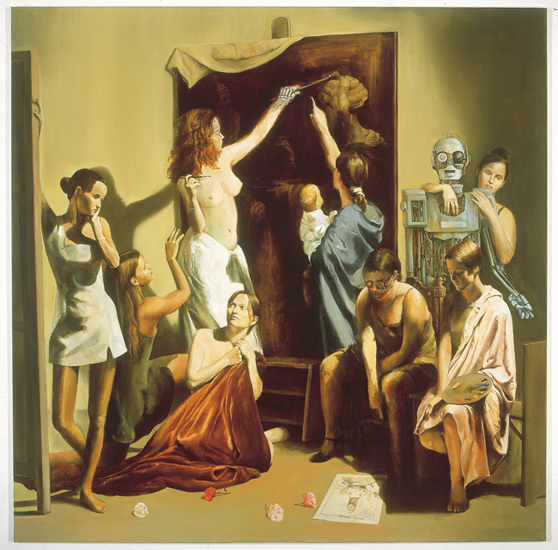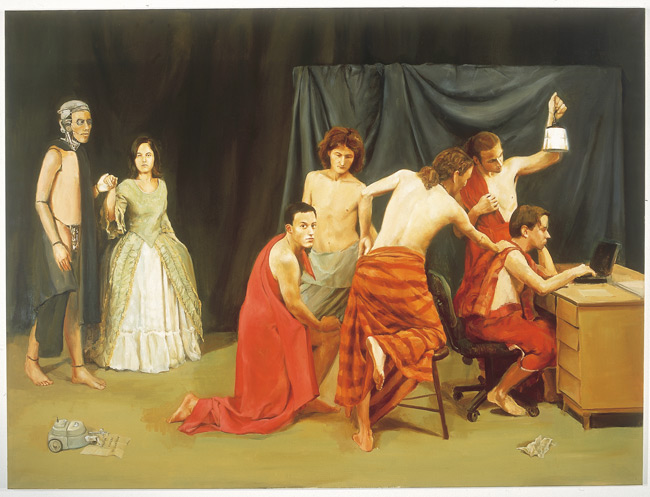JANOS KOSA “PAINTER ROBOTS”
HAPPENINGText: Mark Griffith
In contrast to last month’s affectionate collaboration of art and computer science – Chatterbots at C3 – April in Budapest sees a curious exhibition of paintings which show exactly the opposite: thinly-veiled hostility towards computers from an artist.
The mood of the paintings is odd, and says a lot about Hungarian separateness, the tendency of Magyar artists to stay at a distance from international art trends, follow them in parallel, or strike out on a completely different path altogether.

Painter, János Kósa, 2000, Painting, oil on canvas 195 x 195 cm Photo courtesy of the Hungarian University of Fine Arts
Janos Kosa (Budapest, 1962–) has created an interesting set of paintings which are as self-consciously painterly as any I have ever seen. They follow formal European patterns of perspective and subject last uncontroversially championed in 18th-century illustration. Many openly mimic famous canvases, with arrays of historically-dressed figures, some in Classical togas, many in collections of people who seem to belong to Velasquez studies of interiors. The pictures are largely bare of the kind of detail we would see in a Velasquez or a Delacroix – without period furniture or contemporary tools or playthings to go with the people.
But every picture has, somewhere in the stiff, formal scene, a robot or a computer. The pictures are less anachronistic than they seem to intend, since Kosa has rarely fixed them in one age.

Hackers II, János Kósa, 1997, Painting, oil on canvas, 150 x 200 cm Photo courtesy of the Hungarian University of Fine Arts
A typical picture collects together elegant though slightly expressionless beautiful young women (no shortage of artists’ models for that type on any Budapest street) some in vaguely pre-19th-century wear, some in standard Greek toga-type outfits, in an room looking like the caricature of an empty artist’s studio. The empty studio could be from de Chirico, Dali, Magritte. Somewhere in this scene is a robot who is straight out of a 1950s Fantastic Tales illustration – an unironic depiction of what was already a wry joke when George Lucas put C3PO in Star Wars as the comic robo-butler. In some the look is a kind of mix of Stanley Spenser’s pre-war paintings, but without his spiritual force, and Tamara de Lempicka’s 1920s portraits, but without her stylised stylishness.
As so often with what passes for irony in this part of Europe, these ‘ironic’ juxtapositions are deadly unfunny. In one drawing, three emaciated naked men, part William Blake, part German Expressionist, are the only solid objects in a line-drawn workstation with computer that puzzlingly encompasses them with its inhuman, diagrammatic unreality.
Kosa could scarcely shout louder in each picture his labored message: computers are cold, inhuman, unpleasantly abstract and unemotional …. oh, and he doesn’t like them either.
Read more ...





